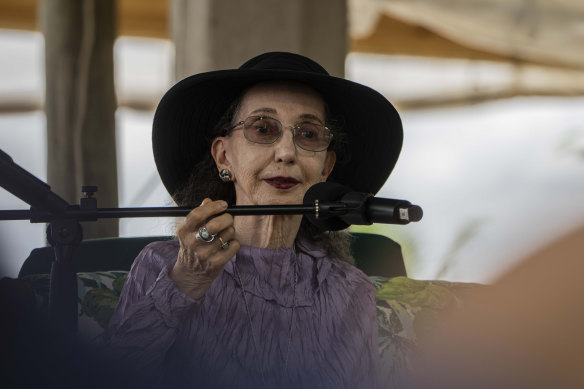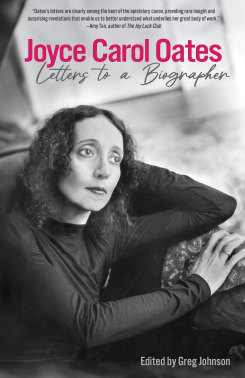
Joyce Carol Oates is sifting through old letters. Some were written nearly half a century ago. Reading them in chronological order is akin to your life flashing before your eyes, the 86-year-old American author explains from her home in New Jersey: “One part of me wants to look at the past, but another part feels so sad that so many people are gone.”
I last spoke to Carol Oates 13 years ago. She had then just published A Widow’s Story. Raw, emotional, and visceral, it provided an unedited account of the grief she experienced in 2008 after losing her husband of 47 years, Raymond Smith, with whom she founded the literary magazine The Ontario Review.

Joyce Carol Oates speaking at a literary festival in Jamaica last year. The book of her letters focuses largely on her prolific output of writing.Credit: The New York Times
Smith is mentioned with great affection, many times, throughout Letters to a Biographer. The letters (which span from 1975 to 2006) are between Carol Oates and Greg Johnson. Eventually, he became her biographer, publishing Invisible Writer: A Biography of Joyce Carol Oates (1998). But when they first crossed paths, Johnson was a fresh-faced English major. Carol Oates was then already one of the most famous writers in America, having won the National Book Award in 1970 for her novel them (1969). Several of her stories had also been included in Best American Short Stories volumes.
The American author remembers the first letter she received from Johnson. He mentioned a story she had published about a student who had taken their own life. Johnson found great comfort in the story since his professor had killed himself around this time. “I wrote back because I liked Greg’s voice,” Carol Oates recalls.

Credit:
Reading these letters, however, one senses this is not a relationship of equals. Johnson’s letters are not included here. Instead, we just get responses from Carol Oates, with some introductory comments from Johnson. Even then, he always appears to be the rookie writer — or a fanatical fan, even — constantly looking up to a figure he is clearly in awe of.
Still, it was, and remains “a warm and sympathetic friendship” as Carol Oates puts it. Their decades long correspondence discusses a wide range of topics: personal matters, family, travel, boxing, the AIDS epidemic, their shared love of animals, and, most importantly, literature.
There are some occasional references to petty jealousies and healthy literary rivalries too. Carol Oates, after all, befriended some of the most famous American writers of the 20th century, including Truman Capote, Philip Roth, Saul Bellow, Joan Didion, Susan Sontag, Norman Mailer, Cynthia Ozick, Stephen King, Toni Morrison, Kurt Vonnegut, Margaret Atwood, and John Updike.
Mostly, though, these letters focus on Carol Oates’ prolific output of writing. She is the author of more than 70 books, which includes short-story collections, poetry volumes, plays, essays, and an impressive output of journalism too. Among her bestselling books are We Were the Mulvaneys (1996) and Blonde (2000). The latter presents a fictionalised take on the life of Marilyn Monroe. The former is a novel telling the story of the Mulvaney family’s fall from grace in the rural town of Mount Ephraim, New York, after Marianne Mulvaney is raped by a local boy. The book went on to sell 3 million copies – thanks, in part, to Carol Oates’ appearance on Oprah’s Book Club in January 2001.









 Add Category
Add Category